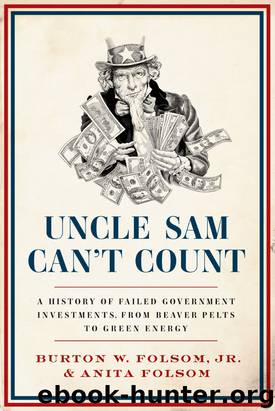Uncle Sam Can't Count by Burton W. Folsom Jr. Jr

Author:Burton W. Folsom Jr., Jr.
Language: eng
Format: epub
Publisher: HarperCollins
Published: 2013-03-10T16:00:00+00:00
7
The D.C. Subsidy Machine
In the 1930s, the United States made a crucial transition in the history of government intervention. Before then, government subsidies were damaging, but infrequent. After the 1930s, government subsidies proliferated and became part of American life. Why did this happen? First, before 1930 subsidies were usually found to be inconsistent with the Constitution. Second, Congress was held accountable for them. When Congress funded Collins’s steamship company, the Union Pacific Railroad, or Samuel Langley’s aerodrome, congressmen—who had to run for reelection—were accountable to voters for the results. In all three of these examples, the failure of the subsidy created a political backlash; Congress, often after much public embarrassment, stopped these subsidies.
Both of those barriers were knocked down in the 1930s. The Great Depression hit the nation, and the presidencies of Herbert Hoover and Franklin Roosevelt changed the way government operated. First, the new appointees to the Supreme Court increasingly viewed the Constitution as a mere guide, not binding law. Second, Congress—with much help from Hoover and FDR—created new government agencies with the power to award many subsidies. Congress funded the agencies through annual appropriations, but the bureaucrats in the agencies, not Congress, doled out the federal cash. In other words, unelected government bureaucrats would be liberally funded by Congress to give away other people’s money on whatever projects they chose.
In many ways, the most dramatic new government agency of the 1930s was the Reconstruction Finance Corporation (RFC). Designed to lend or give cash to industries, the RFC was a new type of government entity, one not even imagined by the Founders. Never in U.S. history (except during World War I) had the United States established an independent agency with power to lend millions, and later billions, to corporations. The board of the RFC, not Congress, gave this money away to the corporations it chose. And the RFC chose many corporations in many different industries.1
President Hoover first promoted the idea for the RFC in 1931, during the Great Depression. When he saw thousands of banks going broke, and Americans losing their savings, he reacted. Also, many key corporations—railroads, for example—were going bankrupt, which disrupted commerce and threw millions of Americans out of work. The RFC, Hoover insisted, should be instituted to make loans (or gifts) to these banks and railroads, which would halt the cycle of bankruptcy and unemployment. Thus, in October 1931, Hoover approached congressional leaders with his idea for a heavily funded RFC. In the meeting, Hoover said he “hoped those present would approve my program in order to restore confidence, which was rapidly degenerating into panic.” Most congressmen, according to Hoover, “seemed shocked at the revelation that our government for the first time in peacetime history might have to intervene to support private enterprise.”2
Hoover’s statement overlooked the government interventions that had already helped to cause the Great Depression and then made it worse. First, in 1928 and 1929, the Federal Reserve raised interest rates four times, which made it harder for businessmen to borrow money to invest, and that hindered economic growth.
Download
This site does not store any files on its server. We only index and link to content provided by other sites. Please contact the content providers to delete copyright contents if any and email us, we'll remove relevant links or contents immediately.
The Secret History by Donna Tartt(18840)
The Social Justice Warrior Handbook by Lisa De Pasquale(12141)
Thirteen Reasons Why by Jay Asher(8792)
This Is How You Lose Her by Junot Diaz(6780)
Weapons of Math Destruction by Cathy O'Neil(6142)
Zero to One by Peter Thiel(5684)
Beartown by Fredrik Backman(5594)
The Myth of the Strong Leader by Archie Brown(5423)
The Fire Next Time by James Baldwin(5247)
How Democracies Die by Steven Levitsky & Daniel Ziblatt(5127)
Promise Me, Dad by Joe Biden(5087)
Stone's Rules by Roger Stone(5026)
A Higher Loyalty: Truth, Lies, and Leadership by James Comey(4842)
100 Deadly Skills by Clint Emerson(4840)
Rise and Kill First by Ronen Bergman(4701)
Secrecy World by Jake Bernstein(4643)
The David Icke Guide to the Global Conspiracy (and how to end it) by David Icke(4624)
The Farm by Tom Rob Smith(4434)
The Doomsday Machine by Daniel Ellsberg(4415)
